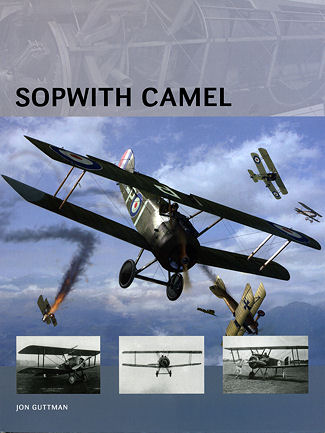 Moving on in
their 'Air Vanguard' series, the third title is on the Sopwith Camel. Osprey
seems to be spreading things around a bit in terms of eras and this is, so far,
one of the earliest aircraft done.
Moving on in
their 'Air Vanguard' series, the third title is on the Sopwith Camel. Osprey
seems to be spreading things around a bit in terms of eras and this is, so far,
one of the earliest aircraft done. Osprey's Sopwith Camel
|
Author: |
Jon Guttman |
|
Publisher/Distributor |
Osprey Publishing |
|
Price |
$18.95 MSRP |
|
Reviewer: |
|
| Notes: |
64 pages, 7¼ x 9¼
inches, softbound ISBN: 978-1-78096-176-7 |
 Moving on in
their 'Air Vanguard' series, the third title is on the Sopwith Camel. Osprey
seems to be spreading things around a bit in terms of eras and this is, so far,
one of the earliest aircraft done.
Moving on in
their 'Air Vanguard' series, the third title is on the Sopwith Camel. Osprey
seems to be spreading things around a bit in terms of eras and this is, so far,
one of the earliest aircraft done.
During WW1, aircraft development was at one of its fastest paces ever. Sopwith's team had designed some very successful aircraft starting with the 1 1/2 Strutter, a two seater that was used as a bomber, recce plane and with the forward cockpit covered over, as a fighter. This led to the delightful Sopwith Pup, but the need was there to increase the armament from the single gun so the Camel was developed. This carried twin guns and a more powerful engine, something that the Pup could not handle.
The result was an aircraft with much of its weight in the forward section of the airframe and it was this that made it such a tricky plane to learn. It also made the Camel extremely maneuverable, something that the Germans came to respect as the war went on. This maneuverability came at a bit of a cost as the Camel was not the fastest in a straight line nor could it dive all that well. By the last year of the war, the faster and less maneuverable German planes were operating with hit and run tactics against the Camel so negating its major benefit.
For the Royal Naval Air Service, a shipboard version, the 2F1 was developed. This generally had a single gun on the fuselage and one above the wing. It was the main aircraft that operated from the first aircraft carrier, HMS Furious. Unfortunately, as the ship was not built as a carrier, it had a launching deck in the front and a recovery deck on the rear with the ship's funnel and bridge in the middle. This sort of make landings impossible as there was no arrestor hook system yet worked out. However, the planes could take off and once completing a mission, simply crashed into the sea for the plane and pilot to be rescued. Several missions were undertaken in this manner late in the war.
The Naval Camel also was launched from platforma atop guns or from sleds towed by ships. Again, landing was the major issue and ditching was the only real option.
Not only did the Camel operated in Western Europe but also in the Near East during the last year or so of the war. Many were operated by the Greek Air Service against the Turks. Even post war, the Camel was used against the Bolsheviks in the various wars against the new Soviet Union and some came to be in the air forces of the Baltic States and Poland. The US operated several Camels, but mostly as trainers and hacks as they were seriously obsolete by the end of the war.
As with other books in this series, author Jon Guttman covers the aircraft's initial design and development as well as its introduction into unit service. Much of the book is dedicated to its combat record, as well it should. In this part of the publication we get the majority of pilot stories. The book is full of period photos as well as profiles and other artwork to make for a well rounded title. In line with the previous title, this one has a back page foldout that provides a cutaway of the Camel, a nice feature of this series.
In all, a book I can highly recommend and I very much look forward to others in this series.
November 2012
For more on the complete line of Osprey books, visit www.ospreypublishing.com. In the US, it is Osprey Direct at 44-02 23rd St, Suite 219, Long Island City, NY 11101., where you can get a catalogue of available books.
If you would like your product reviewed fairly and fairly quickly, please contact the editor or see other details in the Note to Contributors.